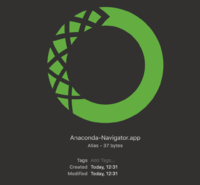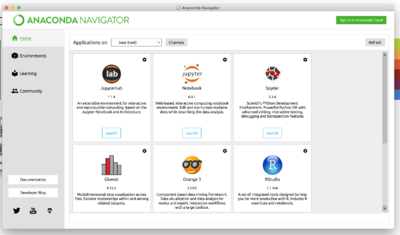OSX set up Python (Anaconda): Difference between revisions
→Download and install Python: a few instruction tweaks |
|||
| Line 2: | Line 2: | ||
We're going to be installing Python using a collection of software that includes Python that, as a collection, is called '''Anaconda'''. Anaconda includes the Python programming language and a bunch of different pieces of software that are useful for data science and analysis. Although the collection includes all free software, it is put together by a commercial company called '''Continuum Analytics'''. | We're going to be installing Python using a collection of software that includes Python that, as a collection, is called '''Anaconda'''. Anaconda includes the Python programming language and a bunch of different pieces of software that are useful for data science and analysis. Although the collection includes all free software, it is put together by a commercial company called '''Continuum Analytics'''. | ||
'''Note:''' Even if you already have a version of Python on your computer, we suggest you follow these instructions and download Anaconda. This will help ensure that you can follow along during our in-class activities, and will make it easier for mentors to help you if you get stuck on something. | |||
=== Installation option #1 === | |||
<font size="+1">Try to download and install Anaconda from [https://communitydata.science/~mako/Anaconda3-2019.10-MacOSX-x86_64.pkg this file which contains Python 3.7 for OSX].</font> | <font size="+1">Try to download and install Anaconda from [https://communitydata.science/~mako/Anaconda3-2019.10-MacOSX-x86_64.pkg this file which contains Python 3.7 for OSX].</font> | ||
If | === Installation option #2 === | ||
If option 1 above doesn't work for any reason, download and install the Python 3.7 option from [https://www.anaconda.com/distribution/#download-section Anaconda's website], on the right. If necessary, scroll down to the "Anaconda 2019.10 for macOS Installer" section. | |||
<gallery> | <gallery> | ||
Revision as of 00:41, 15 January 2020
Download and install Python
We're going to be installing Python using a collection of software that includes Python that, as a collection, is called Anaconda. Anaconda includes the Python programming language and a bunch of different pieces of software that are useful for data science and analysis. Although the collection includes all free software, it is put together by a commercial company called Continuum Analytics.
Note: Even if you already have a version of Python on your computer, we suggest you follow these instructions and download Anaconda. This will help ensure that you can follow along during our in-class activities, and will make it easier for mentors to help you if you get stuck on something.
Installation option #1
Try to download and install Anaconda from this file which contains Python 3.7 for OSX.
Installation option #2
If option 1 above doesn't work for any reason, download and install the Python 3.7 option from Anaconda's website, on the right. If necessary, scroll down to the "Anaconda 2019.10 for macOS Installer" section.
-
Make sure you download the version for Python3
-
Opening the file with Package Installer will guide you through the setup process
-
You may be prompted for your password
-
Package Installer will install Anaconda3
Install notes
- If you get stuck during the install process, ask a neighbor or raise your hand for help. These instructions may also be helpful.
- At the end of the installer, you may be prompted if you'd like to send the installation package to the trash. Doing so won't damage the installation and will free up ~600MB of disk space on your computer.

Test your Python install
To use Anaconda on MacOS, you will primarily use the Anaconda Navigator. This software helps manage multiple versions of Anaconda, as well as helps make it easy to launch Jupyter.
The easiest way to launch the Anaconda Navigator is from inside the Applications folder:
The navigator will start up and greet you with a list of installed and available tools:
rest [To Be Decided]
Success!
You have tested your Python installation.






